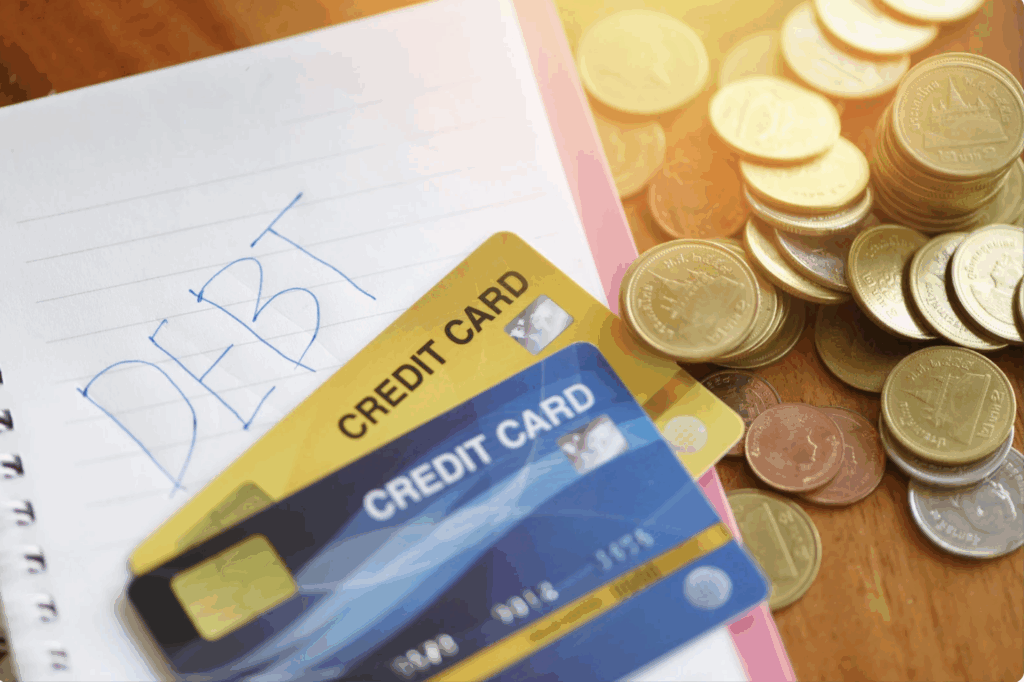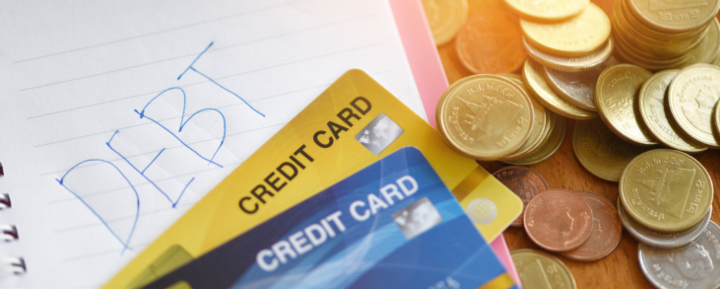Inflation has become a significant challenge for American consumers and businesses, driving up the cost of goods and services across the economy. From groceries and housing to basic needs like healthcare, rising prices are putting financial strain on consumers nationwide.
The Federal Reserve has responded to inflation by raising interest rates, creating a ripple effect that particularly impacts people carrying credit card debt. For millions of Americans, this combination of higher prices and higher interest rates has transformed manageable monthly payments into overwhelming financial pressures, making effective debt management more critical than ever.
The Impact of High Inflation on Credit Card Debt
When inflation rises, it affects your credit card debt in several ways. Understanding these effects helps you make better choices about your money and debt management.
How Inflation Affects Interest Rates
When inflation gets too high, the Federal Reserve raises interest rates. This is part of their plan to slow down the economy and bring prices back down. Most credit cards have variable interest rates that go up when the Fed raises rates. So, your credit card interest rate can jump without warning.
For example, let’s say you have a credit card with an 18% interest rate. When the Fed raises rates, your card might jump to 22% or higher. If you have a $5,000 balance, this increase costs you hundreds of extra dollars each year. Your minimum monthly payment goes up too, putting more pressure on your budget.
Rising Cost of Living and Its Effects on Spending
Inflation doesn’t just affect your credit card rates—it also changes how you spend money every day. When groceries cost more and your rent goes up, but your paycheck stays the same, you might be forced to turn to credit cards to make ends meet. This creates a tough cycle in which you use credit cards more just when carrying debt becomes more expensive.
Many Americans now use credit cards for things they used to pay cash for. Trips to the grocery store, gas for the car, and other basic needs go on the card. This shift from “want” purchases to “need” purchases makes debt harder to pay off. Using credit for basic needs can also add stress that can lead to poor money choices.
Long-Term vs. Short-Term Debt Considerations
High inflation makes timing important with debt. Some types of loans with fixed rates might actually get easier to pay over time as inflation makes money worth less. But credit cards don’t work this way. Since most have variable rates, they get more expensive as rates rise.
This means that the longer you carry credit card balances during inflation, the more you pay in interest. What’s more, your wages might not keep up with rising prices and higher debt costs.
Strategies to Manage Credit Card Debt During Inflation
Managing credit card debt during inflation takes a plan that tackles both your current debt and protects you from future problems. The best way is to use several strategies together.
Here are a handful of strategies that work together to reduce your debt burden.
Reviewing and Prioritizing Debt
Start by making a list of all your credit cards. Write down the balance, interest rate, and minimum payment for each one. Look for any special promotional rates that might be ending soon. This gives you a clear picture of what you owe and helps you spot opportunities.
Once you have your list, decide which debts to pay off first. You have two good options. The avalanche method involves prioritizing paying off the cards with the highest interest rates first, which can save you the most money over time.
In contrast, the snowball method involves prioritizing your debts with the smallest balances first. This can give you quick wins that keep you motivated.
Reducing Credit Card Usage
To get ahead of your debt, you need to stop adding to it. This means changing how you pay for things.
For example, using cash makes spending feel more real. When you hand over actual money, you think more about each purchase. Start using cash for fun expenses like eating out or entertainment. Then try using cash for other purchases where it makes sense. This helps you spend less and become more aware of where your money goes.
When cash isn’t practical, debit cards are a good option. They’re convenient like credit cards, but only let you spend money you actually have in your account. Just make sure you have enough money in your savings account or checking account to avoid overdraft fees. These fees can cost more than credit card interest.
Lowering Existing Credit Card Balances
Getting rid of existing debt takes a plan that makes the most of whatever extra money you can find. Even small extra payments make a huge difference.
For example, let’s say you have a $5,000 balance and a 22% interest rate. If you were to put $100 per month toward the debt, it’d take you more than 11 years to pay it off, and you’d end up paying roughly $8,678 in interest.
However, if you were to pay $125 per month instead, you’d pay off the debt in just over six years, and your total interest charges would be roughly $4,095. That’s $4,583 in total savings, nearly as much as the original balance.
Using the debt snowball or avalanche approach can be particularly beneficial if you have multiple credit card balances.
You may also consider using a balance transfer credit card to secure a lower interest rate for a while. But be careful; the low rate is usually temporary. When it ends, the rate often jumps higher than your original card. There’s also usually an upfront fee (usually 3% to 5% of the balance). Only do a balance transfer if you have a solid plan to pay off the debt before the low rate expires.
Negotiating Better Terms with Credit Card Issuers
Credit card companies want to keep good customers, so if you’ve been making payments on time, don’t be afraid to call and ask for help. Many lenders have programs for people going through hard times. They might lower your interest rate, waive late fees, or even let you skip payments temporarily.
When you call, be polite and be honest about your financial situation. Ask for specific help, like lower rates or waived fees. Get any agreement in writing and make sure you understand how it might affect your credit report or account terms.
Tools and Resources for Managing Debt
If you’re feeling overwhelmed about your debt or you’re simply looking to pay down your balances more effectively, it can help to seek professional advice or use mobile apps.
Credit Counseling
Non-profit credit counseling agencies offer free or cheap financial services. For example, a credit counselor can review your situation and suggest ways to improve it, such as getting on a budget, or using an accelerated repayment strategy or consolidation option.
A credit counselor can also set up a debt management plan, which consolidates your payments and may help you score lower payment amounts, lower interest rates, or even fee waivers. You can find an agency through the National Foundation for Credit Counseling or the Financial Counseling Association of America. Note that not all creditors will work with credit counseling services. In addition, the plan normally doesn’t include a reduction in balances.
Budgeting and Debt-Tracking Apps
Mobile apps can make tracking your debt and budget much easier and more accurate than doing it by hand. Popular options like You Need A Budget and PocketGuard connect to your bank accounts and credit cards to automatically track spending.
Debt-specific apps like Debt Payoff Planner and Tally can help you visualize different payoff strategies and see exactly how much interest you’ll save.
The visual progress tracking—like seeing your debt balance shrink each month—can help keep you motivated to stick with your plan. Some apps even gamify the process by celebrating milestones, which helps during the tough months when progress feels slow.
Debt Settlement
If you’re already behind on payments or facing default, debt settlement might be an option worth considering. These programs work by negotiating with lenders to accept less than the full amount owed. This typically happens when you’re several months behind on payments, and the credit card company would rather get some money back than none at all. Even if you’ve been served, it may be possible.
But while debt settlement can significantly reduce what you owe, it could negatively impact your credit score and may have tax consequences since forgiven debt is often considered income. It’s important to work with a reputable debt settlement attorney rather than a random debt settlement company who solicits you. An attorney who is experienced with resolving debt for consumers with creditors can guide you through the process and help you understand all the risks and benefits before making this decision.
Building Financial Resilience
Getting out of debt is just the first step. To protect yourself from future financial problems, you need to build resilience that can handle whatever the economy throws at you.
This means creating safety nets and income sources that keep you stable even when inflation rises or unexpected expenses pop up.
Develop an Emergency Savings Fund
Even a small emergency fund can prevent you from using credit cards when unexpected things happen. Start with a goal of $500 to $1,000 in a savings account. Then work toward having three to six months of expenses saved up.
Set up automatic savings so you save consistently, even if it’s just a little at a time. This money acts as a buffer, so you don’t need to use credit cards for things like medical bills or car repairs.
Find Additional Sources of Income
When everything costs more, extra income becomes increasingly important for financial stability. Look for freelance work, a part-time job, or ways to make money from skills you already have. Put any extra money you earn toward paying off debt and then use the funds to bolster your emergency savings.
Review and Adjust Financial Goals
During periods of high inflation, it’s important to be realistic about your goals. For example, it may be more important right now to focus on getting rid of high-interest credit cards and building emergency savings than it is to save up for a home down payment or increase your non-retirement investments.
As your financial foundation stabilizes, you can readjust your goals to better fit your improved situation.
The Bottom Line
Inflation makes credit card debt harder to manage, but it’s not impossible. Rising prices and higher rates create challenges, but they also give you a reason to build better money habits. Today’s tough economic conditions may require you to take action, but people who act smart can get through these challenges successfully.
The best ways to protect your financial future involve taking action now instead of waiting for things to get better.
If your credit card debt has gotten out of hand, and you’ve already fallen behind on payments, consider seeking professional legal advice to explore debt settlement or other solutions to help you avoid bankruptcy. Getting the right guidance is crucial when dealing with serious debt problems. Contact Tayne Law today via our online contact form or call (866) 890-7337 for a no obligation phone consultation. Your information is never shared or sold.





